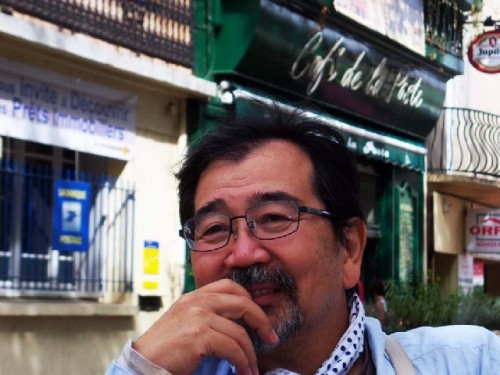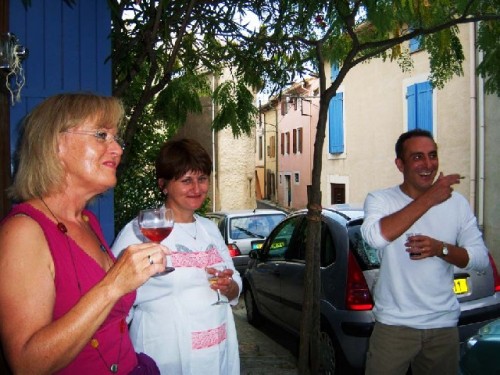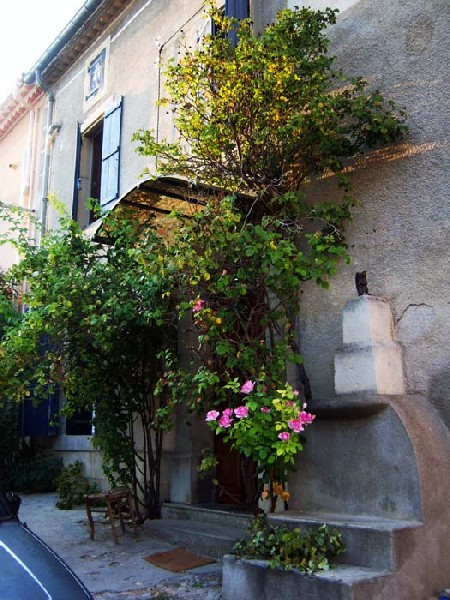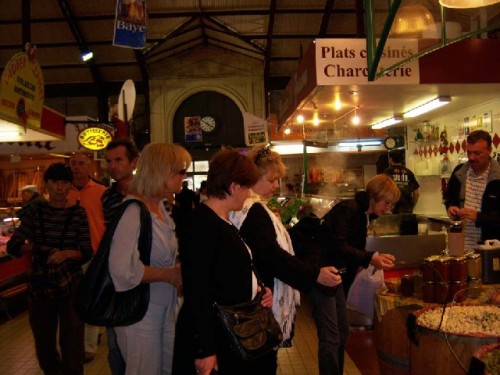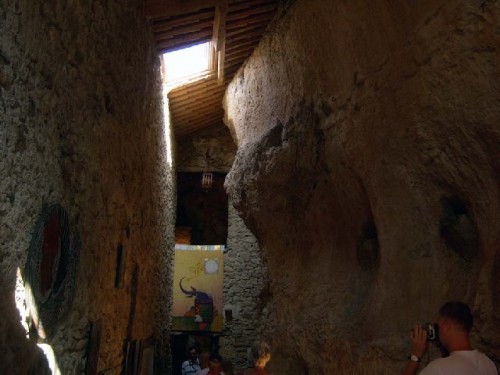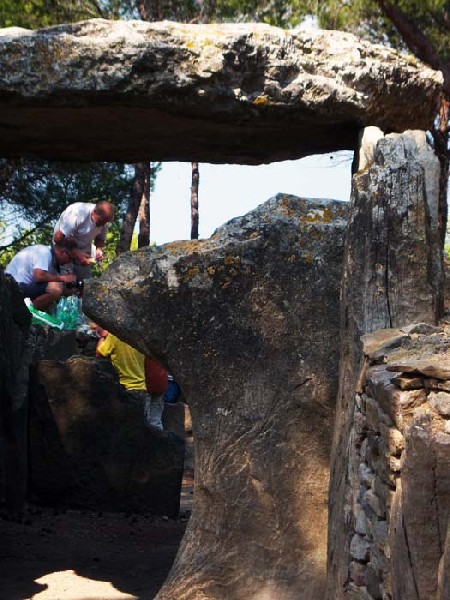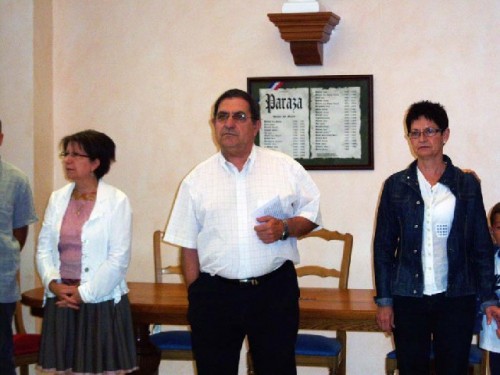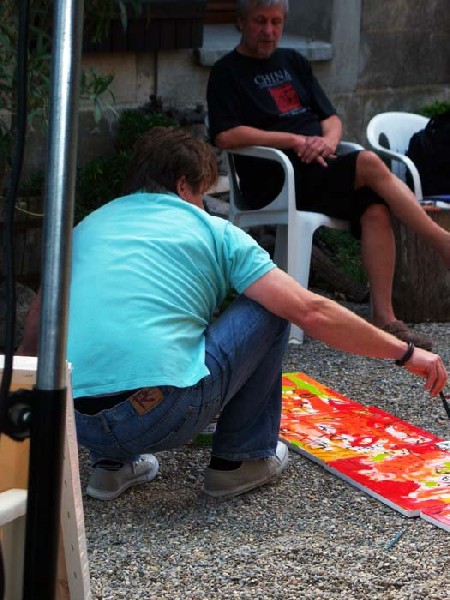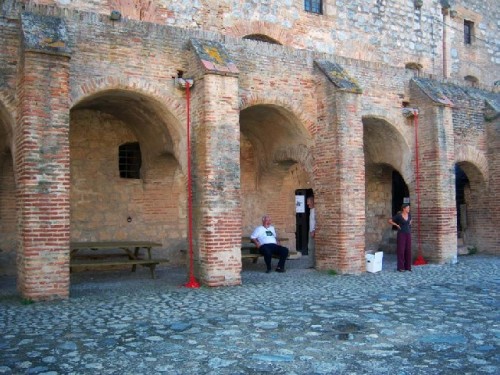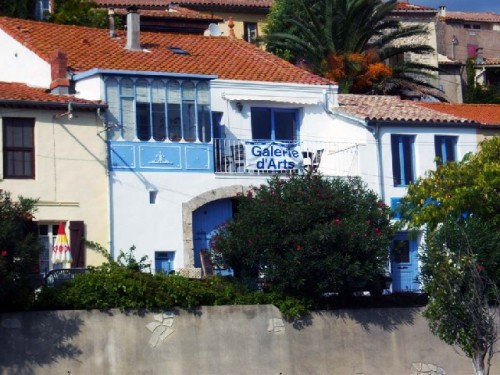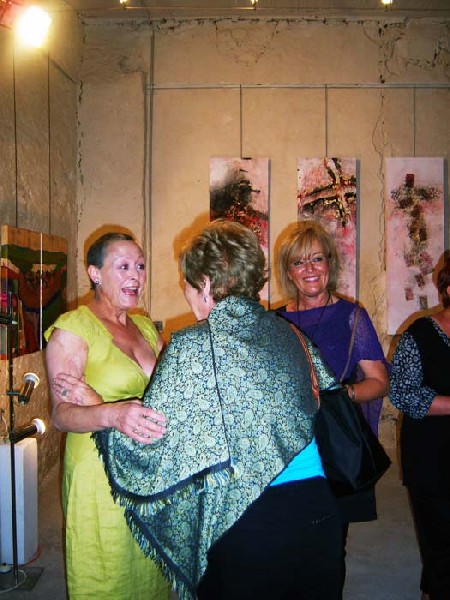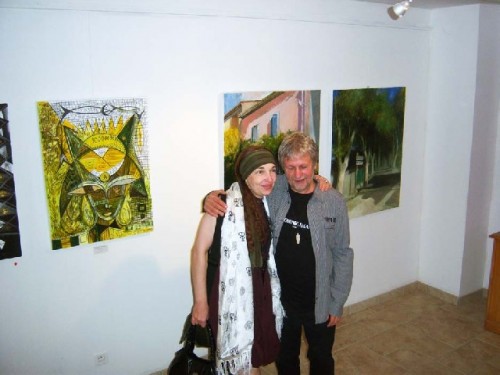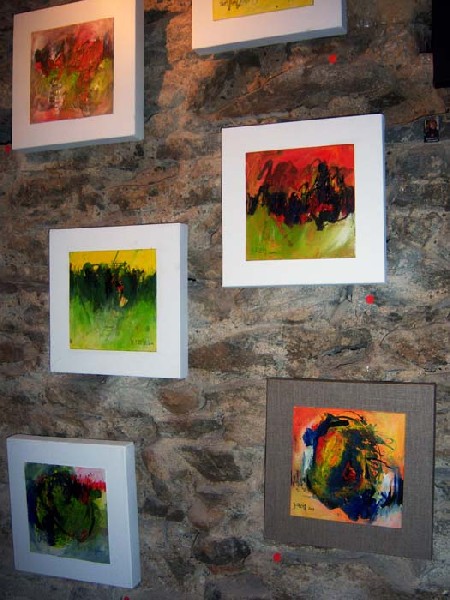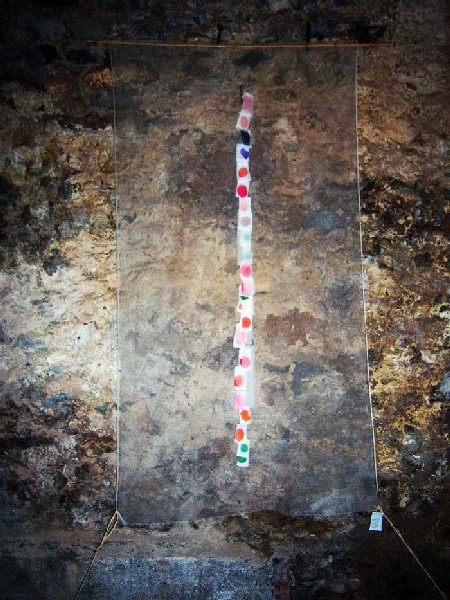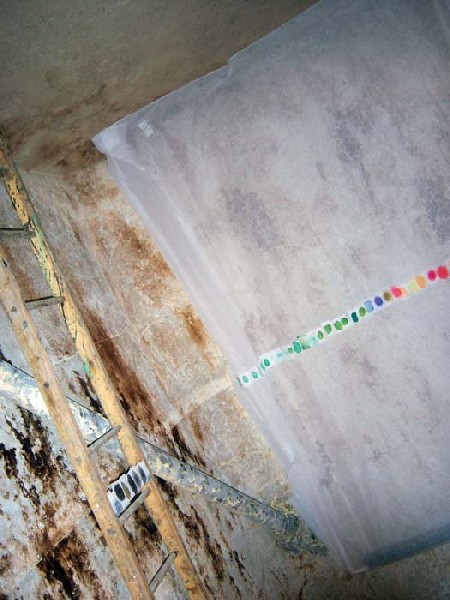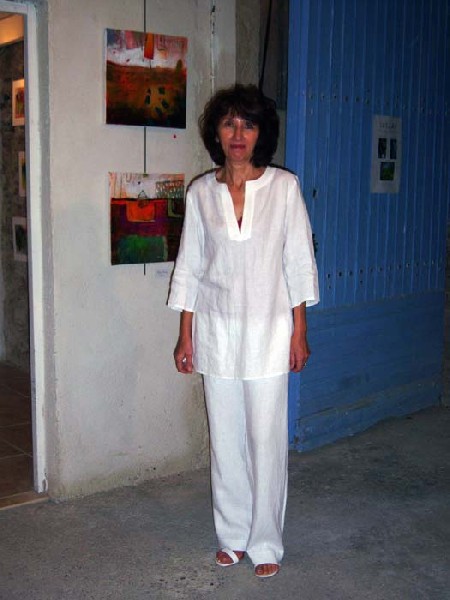The 12th International Symposium of Contemporary Art, in Paraza, France
Organized by Dorothea Fleiss & East West Artists, Stuttgart, Germany
By: Astrid Hiemer - Oct 10, 2009
Sponsors and Local Councils: Dorothea Fleiss and East West Artists, Stuttgart, Germany with Maison Endriss, Paraza and
Gallery/Association, Le C.L.A.P. and Le Pont, Paraza
Participating Artists: Lyudmila Dakhova, Ukraine – Dorothea Fleiss, Germany – Padungsak Kochsomrong, Thailand – Istvan Korbely, Hungary - Kalman Maklary, Hungary – Mate Rainer, Hungary – Takata Yoshiki, Japan
Invited Writers/Reporters: Astrid Hiemer, USA – Charles Giuliano, USA
Google Earth is a fabulous thing ! It could pinpoint our house as a dot in the hillsides of the Berkshires, and it also indicated the village of Paraza in the region of Langedoc-Roussillon in southern France. The village, with less than 600 inhabitants, was too small to mark a dot on our official road map of France. Therefore, following Google's directions, turn off the highway from Toulouse to Montpellier at Lezignan-Corbieres, past Carcassonne. Then pass the village of Roubia on a sandy country road after approximately 5 km through fields and vineyards. Continue on that road another 3 km. Driving along the Canal du Midi, we knew that we were close to Paraza.
A left turn into the village, over a bridge, now crossing the canal, then up a plane tree lined drive – then, we did not know where to go. Luckily a spunky English women asked us to follow her. She knew about the International Symposium of Contemporary
Art and we landed in a fairly spacious parking lot. The rented Citroen/4, named "Picasso" (really – a good omen !) was safely parked. Village and country roads are small and smaller, but the people drive their small cars or fast BMWs almost like race cars.
The commotion on the parking lot alerted Werner Endriss, one of our hosts, to look up. He recognized us from our photos on the poster and beckoned us to walk down the tiny steps to his level. He and Dorothea Fleiss, the organizers of the symposium, greeted us with open arms. We had last seen Dorothea in Boston, Massachusetts, at the Conference for International Opportunities in the Arts, a few months earlier. We were introduced to Christine, Werner's lovely wife, and three Hungarian artists, Istvan Korbely, Kalman Maklary, and Mate Rainer. They had driven to Paraza with Magdalena Bus (Babi), who is Romanian. Babi would lovingly and famously take care of our physical needs with food and drink for the duration of the retreat. Soon everybody, well, the men more reluctantly after Charles lead the charge, would help with clearing the table. A couple of women in the group would also set the table, fill the dishwasher, put away food, and assisted Babi, when possible.
Three meals a day for twelve people, during ten days, counts for many meals and much food. Christine and Babi went shopping. Our daily meals consisted of wonderful Romanian dishes, fresh market ingredients, and French delicacies like cheeses, salamis and pate, olives, and baguettes or country bread. French wines, it was harvest season in southern France, and different sorts of other alcoholic beverages, would help to enliven long evenings of conversations, guitar music, and song, led by Istvan and Kalman. Both spoke little English and so contributed musically to the entertainment with their guitars and many American songs. At any time one could hear conversations in French, English, German, Hungarian, Romanian, Russian, and more.
Takata Yoshiki from Tokyo, had also already arrived. He flew in to Paris, then took the train to Narbonne, a town 12 km away. Padungsak Kochsomrong (Toi, which means in the Thai language - liking small things), who had made his way from Northern Thailand to Bangkok, then Paris, would be picked up that same evening. But where were Lyudmila Dakhova and artists from China, Italy and Spain ? It turned out, that Lyudmila was currently stranded in Paris. Her friend, Natasha, who had planned to drive her to Paraza was sick with the flu in Paris and Lyudmila now also had the bug. She had already traveled from Northern Ukraine to Kiev in order to receive her visa for France, then 30 hours on a bus ride to Paris. That already accounted for a week on the road !
There was no money left for the train, but clearly she had much determination and trust in positive forces of the world. Werner came once more to the rescue and would pay for her round trip ticket. It turned out that the sculptors in the group had to commit in the end to other important projects and were not able to attend. The great chunks of wood, which were reserved for them, may now be turned into Werner's pieces. He had started a year ago to work with wood and models.
The artists were living at Maison Endriss in the village, also with Johanna van Dijke, and Anneben Ogier and Hilde Boonstra along the canal. We were very comfortably assigned to Dirk van der Elst and his wife Mirelle Schellaert, in our own guest house, on the outskirts of the village. Dirk and Mireille swim daily and we also enjoyed using their lap pool. Life in the southern landscape is breathtakingly beautiful. The region is dotted with vineyards, olive trees and olive mills, orchards, villages, castles, and Roman ruins. The dry and sandy soil supports pines, tall cedars, and palm trees, with mountain ranges as a backdrop.
Seven artists eventually settled into their common studio. They wanted to work together and Madame Antoinette Klute, who was not presently in town, made her compound available to them, and Madame Elisabeth, a relative of Christine's, allowed us to use her car for outings. So, the group painted in a transformed studio and courtyard and had a beautiful home available for occasional chess games and interludes. Dorothea provided inspiration and the drive for long hours of work time. She and Lyudmila actually painted twice through the night. We observed the artists daily in their studio and were astonished by their productivity. The quality of the work was impressive, and the exhibition at the end of the week was looming large. Takata, a conceptual and installation artist, would wander around the village to absorb its essence, in order to come to decisions for his installations. "I am thinking," was his mantra for a few days.
Still, the group managed a couple of adventurous trips into the region. We visited Narbonne and its cathedral, a sea side town at the 'Golfe du Lion,' where 'the Hungarians' actually took a dip into the Mediterranean Sea. We saw the most dramatic sites in Minerve. The village was built on a huge rock formation and is still limited by the former medieval fortress walls. It can only be reached via a couple of bridges; so we parked outside of Minerve and hiked up and down the narrow roads. We were taken to a gallery and home, where the owners had spent eight years to clear and clean open spaces in the fortress walls. The property had been a water collection point, a cistern for the village, and was a natural water runoff for centuries. It prevented deterioration over hundreds of years. It was the most dramatic natural gallery and home, that we have ever encountered !
The Aude region was populated by the Cathares, a Christian sect believing in pure and simple living. They denounced the wicket ways of the medieval popes and were brutally destroyed in the course of many decades. There are actually 19 sites in the region: Abbeys, castles, and museums, which honor the history of the Cathars and thousands of other citizens, who were killed by the avenging Christian Crusaders.
We visited the Benedictine Abbey of Caunes-Minervois, where the well known Caunes marble, a pink and red stone, had been incorporated in many details of the church. Its oldest parts date back to the 12th century. We entered the crypt with pavement stones possibly dating back to the 8th century. Takata remarked that the pattern, and round stones along the low and narrow foot path reminded him of old Japanese stone work.
Since we were invited to be observers and writers for the project, we had time for excursions into the surroundings, which we did. Also, Dirk and Mireille invited us to explore another area toward the Pyrenees, the picturesque hill town by the sea, Peiriac, and the Fort de Salses. Many small towns and villages in the regions had been largely abandoned by the original younger population, because of lack of work. Over time, people from northern France, Europe and actually from around the world have renovated and repopulated many towns and villages, and saved them from oblivion.
The beautiful landscape, the hills and mountain ranges, the sea, and the sunny, mostly mild climate, draw an often older population south. But a mistral like wind can also wreak havoc with people and land. We had a delicious lunch at a restaurant owned by a Belgian couple. Dirk and Mireille had met the couple by chance. They are also originally from Aalsi, Belgium, but moved permanently to Paraza four years ago.
We drove further east, in the direction of the Pyrenees. The enormous Fort of Salses was built by King Ferdinand of Aragon at the end of the 15th century, to defend Spain against enemies in the region of Roussillon. We joined the tour, which was lead through massive rooms to house soldiers and their horses and defense and living quarters, towers, a moat, and high walls on several levels. The restored fort is also used for performances and exhibitions. We viewed video installations in these impressive rooms. The 'Red Lines,' which a couple of women artists were just installing from the second level around the entire court yard, caused to pause. We pointed to what appeared to be runoff openings above for rain water. One of the artists responded: "And blood" – hence, the red ropes.
In the middle of the week the group was invited to a reception by the mayor of Paraza, Monsieur Francis Garcia, his staff, and other guests. "Le Pont," (The Bridge) a cultural organization in Paraza, which is headed by Dirk, had arranged for the formal acknowledgment of our presence in the village. Membership and leadership of Le Pont is comprised in equal numbers of the original French population and the newcomers. At the reception, speeches, food, wine, and conversations in many languages flowed.
Friendly folks from the village visited the studio during the week and Maison Endriss, our most welcoming hosts. All made many new friends as time went by, with people from the village, surroundings, and among the group. The Endriss' immediate neighbors, Sandie Mendes Da Silva, a yoga teacher, her husband, Ricardo Da Silva, who owns a video sales business, and their two daughters, Mailys and Jade, gave a wonderful paella party. They are renovating a 'Master House,' big and beautiful, with many intricate original details. My immediate neighbor at the dinner must have felt sorry for me, for not being able to drink the fine wine. He and his family have owned a wine barrel producing business for generations and export also overseas. He loves spending time in California's wine country while visiting clients.
The day of the vernissage at Le C.L.A.P., Saturday, September 19, 2009 arrived. The owners of the exhibition complex, Francois and Nicole Carriere, had moved to Paraza from Marseille a few years ago. The gallery opened as a non profit entity this year, and nearly 100 artists and non artists are members of the association. The property is situated at the Canal du Midi, in a beautiful spot.
There are two fine and typical gallery rooms. The adjacent spaces of a former wine production company are raw, with some areas still red wine stained. They lent themselves beautifully to install Fleiss' tall and small Prayer Paintings and Yoshiki's interactive installations. He hung over the former fermentation room walls gauze like material and added hundreds of round swatches, which he had painted in many colors. They were cut from the same material. The pungent smell of the crushed grapes hung over two wine-making facilities in Paraza, when we walked by them, and in my mind an inspiration to this work. He presented at the opening, water colors and material swatches and invited the crowd to participate by painting their own impressions.
Kochsomrong's intriguingly colorful demi-landscapes, which he titled: "Bangkok - Paris - Paraza," "Paraza," and "Here – ici," and Maklary's abstract paintings were also shown in this area. In a connecting gallery space, Fleiss had installed a grid of small abstracts and on an opposite wall Korbely's work.
The conventional gallery was filled with Dakhova's futuristic works, or as she put it: "Cubistic, like Picasso." They are intricate paintings, full of vision and fantasy. Korbely painted several landscapes, veiled in his very own, lyrical touch. He conveyed to us that he was thankful, that he could produce abstract paintings in Paraza as well, his real passion. As an independent artist in Hungary, he mostly paints landscapes, in order to support himself. And, Rainer's overly voluptuous nudes on black background filled the rest of the gallery space. I had carried home a magazine, which he had bought in Minerve. It was full of nude women with huge and unhealthy 'boob jobs.' Was that his point?
Kochsomrong is also a well known performance artist in Asia. This November he will travel again to Japan to participate at the Matsushiro Contemporary Art Festival. He has been active as an organizer and participant of the Asiatopia International Performance Art Festival in Bangkog and Chiang Mai. He teaches painting at Chiangmai University, Thailand. He felt that in Paraza, he had reached a breakthrough in his paintings and was quite happy with his work. The painting "Paraza" would have found more than one buyer at the opening, a fitting interpretation of the village, where now 18 nationalities reside.
Yoshiki, a respected artist in Japan, had stored his gallery and outdoor installation work on his computer. He showed us a series of exhibitions, where he had wrapped and folded intricately materials over large and small objects, or created sculptures with found materials, white or colorful. As time passed, we were more and more able to communicate with him in English and understand his ideas and his wicket humor.
Maklary appears to be a very sensitive man and artist. One day, he seemed to sense my current physical and emotional state, even though we could only minimally communicate in words. Sincerely, he asked me about my well being. I had barely acknowledged to myself, that my stomach was seriously upset, which resulted also in strong head pain. I would spend days to get back to a normal diet. Others in the group spoke about similar experiences with him. He describes, in statements, his work as manifestations of opposite forces on earth, reality and non-reality, spirituality and mysticism. During the 90s, Maklary had several exhibitions in the US, in New York City, as well as Los Angeles and other venues along the West Coast. During this current decade, he exhibited throughout Europe and is currently looking forward to a new exhibition in San Diego. He loves America !
Dakhova was the most intriguing artist in the group. She spoke no English and Dorothea would communicate with her minimally in Russian or via a language computer-interpreter. But Lyudmila spoke to everybody constantly. She just talked in her waif-like way, lovely, and with big telling eyes. Christine recounted that, at some point, she simply started to translate what Lyudmila had said. Christina speaks no Russian - and Lyudmila's work communicates to us fantastic realities of day and night.
Fleiss explained that her daughter, Susie, was currently leaving home in order to begin her studies at university in Stuttgart. She was having a hard time to let her go. Dorothea glued prayers from prayer books on canvases and painted over them with her own prayers, in a compelling manner. She attempts to keep her family safe – as well as the world. Since the 90s Fleiss has worked and exhibited on most continents as a painter and video and installation artist. She has organized symposia and artist retreats in her native Romania, Germany, China, and now in France.
In the end, the 12th International Symposium of Contemporary Art brought a village together and visitors from neighboring communities as well as three continents. The opening was a wonderful occasion. We gave speeches and explained to all, how Paraza became for ten days the center of the universe for a group of artists and writers, punctuated by the usual ups and downs of daily life. That evening, hundreds of people came and celebrated with us our artists and their fine works. Everyone there had made at least one new friend. What else can one wish for ?!


